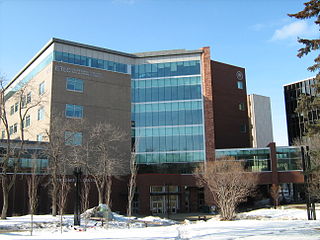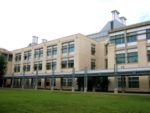History
The precursor to the school of engineering dates back to 1851, when Duke was known as Normal College and located in Randolph County, North Carolina. At that time, engineering was included in a classical course for seniors. A course in engineering was introduced in 1887, eventually becoming a regular course offering in 1903. ' At that time, engineering courses were limited to such fields as architecture and surveying until 1924, when Trinity College was renamed Duke University. Engineering was taught in the new separate departments of civil and electrical engineering. In 1931, a mechanical engineering department was created. Duke's Board of Trustees created the College of Engineering in 1939, with William H. Hall its first dean.
The College of Engineering graduated its first female graduates in 1946. The next year, the three departments moved from East Campus to West Campus. It became the Duke School of Engineering in 1966. Two years later the school's first black students graduated. The Division of Biomedical Engineering was created in 1967 — the first accredited biomedical engineering department at a U.S. university — in September 1972. [21]
In 1997, the Master of Engineering Management was established.
The school was renamed the Edmund T. Pratt Jr. School of Engineering in 1999, in honor of the 1947 graduate and former CEO of Pfizer.
Facilities
Duke Engineering occupies more than 300,000 net square feet of educational, administrative and research space on and near the Duke campus in Durham, North Carolina. [22]
The Duke Engineering campus is adjacent to Duke University Medical Center and 10 miles from Research Triangle Park.
Pratt's faculty, labs, and courses can be found in Hudson Hall, the Nello L. Teer Engineering Building, the Fitzpatrick Center for Interdisciplinary Engineering, Medicine and Applied Sciences (also known as FCIEMAS), Gross Hall, the North Building, the Levine Science Research Center (also known as the LSRC) and in The Chesterfield, a former cigarette factory near downtown Durham that has been redeveloped into academic and industry research space. [23]
Hudson Hall
Hudson Hall is the oldest engineering building at Duke, constructed in 1948. It was renamed to honor Fitzgerald S. "Jerry" Hudson (E'46) in 1992. [26]
Nello L. Teer Building
The Nello L. Teer Library Building opened in 1984. Located adjacent to Hudson Hall, it is now called the Nello L. Teer Building, and houses the Dean's offices, a computing lab, a circuits lab, an auditorium and a student lounge. The building's name honors Teer, its donor and a Durham, North Carolina-based builder and philanthropist. [26]

Wrocław University of Science and Technology is a technological university in Wrocław, Poland. With buildings and infrastructures dispersed throughout the city, its main facilities are gathered at a central location near Plac Grunwaldzki, alongside the Oder river. It operates three regional branches in Jelenia Góra, Legnica, and Wałbrzych. Huffington Post UK named Wrocław University of Science and Technology in the top 15 of the World’s Most Beautiful Universities Rankings.

Łódź University of Technology was created in 1945 and has developed into one of the biggest technical universities in Poland. Originally located in an old factory building, today covering nearly 200,000 sq. meters in over 70 separate buildings, the majority of them situated in the main University area. Almost 15,000 students are currently studying at the university. The educational and scientific tasks of the university are carried out by about 3,000 staff members.

Bialystok University of Technology is the largest technical university in northeast Poland.
The College of Engineering, formerly the Dwight Look College of Engineering, is the engineering school of Texas A&M University in College Station and is home to over 15,000 students in 14 departments.
The University of British Columbia (UBC) is a Canadian public research university with campuses in Vancouver and Kelowna, British Columbia. The following is a list of faculties and schools at UBC.
The School of Engineering and Applied Science (SEAS) at the George Washington University in Washington, D.C. is a technical school which specializes in engineering, technology, communications, and transportation. The school is located on the main campus of the George Washington University and offers both undergraduate and graduate programs.

The Yale School of Engineering & Applied Science is the engineering school of Yale University. When the first professor of civil engineering was hired in 1852, a Yale School of Engineering was established within the Yale Scientific School, and in 1932 the engineering faculty organized as a separate, constituent school of the university. The school currently offers undergraduate and graduate classes and degrees in electrical engineering, chemical engineering, computer science, applied physics, environmental engineering, biomedical engineering, and mechanical engineering and materials science.

The Technische Universität Ilmenau is a German public research university located in Ilmenau, Thuringia, central Germany. Founded in 1894, it has five academic departments (faculties) with about 4,900 students. Teaching and research are focused on the fields of technology, mathematics and natural sciences, business and media.
The James McKelvey School of Engineering is a part of Washington University in St. Louis. Founded in 1854, the engineering school is a research institution occupying seven buildings on Washington University's Danforth Campus. Research emphasis is placed on cross-disciplinary technologies in the areas of alternative energy, environmental engineering & sustainable technology, biotechnology, information technology, and nanotechnology/materials science.

The Florida International University College of Engineering and Computing, located in Miami, Florida in the United States is one of the university's 26 schools and colleges and was originally established in 1973 as the School of Technology. The College of Engineering and Computing offers bachelor's, master's and doctorate degrees within the college's 8 separate schools, departments and institutes. The college offers online and distance learning courses and programs through the Office of Distance Education. This office was previously known as FIU FEEDS, a statewide distance learning initiative adopted by the college in 1985.

The University of Pennsylvania School of Engineering and Applied Science is the undergraduate and graduate engineering school of the University of Pennsylvania, a private research university in Philadelphia. The school offers programs that emphasize hands-on study of engineering fundamentals while encouraging students to leverage the educational offerings of the broader University. Engineering students can also take advantage of research opportunities through interactions with Penn’s School of Medicine, School of Arts and Sciences and the Wharton School.

The Herbert Wertheim College of Engineering is the largest professional school, the second largest college, and one of the top three research units at the University of Florida. The college was founded in 1910, and in 2015 was named in honor of Herbert Wertheim – a serial inventor, philanthropist and UF Distinguished Alumnus. Located on the university's Gainesville, Florida campus, the college is composed of nine departments, 15 degree programs, and more than 20 centers and institutes. It produces research and graduates in more than a dozen fields of engineering and science including: aerospace, agricultural, biological, biomedical, chemical, civil, coastal, computer, computer science, digital arts, electrical, environmental, industrial, materials, mechanical, nuclear, and systems.

The University of Alberta Faculty of Engineering is one of the largest engineering schools in Canada in terms of size, international impact, and reputation. The faculty is home to 1 Canada Excellence Research Chair, 16 Canada Research Chairs, 13 Natural Sciences and Engineering Research Council chairs, and 5 Foundation Supported Chairs.
The College of Engineering and Applied Science is the engineering and applied science college of the University of Cincinnati in Cincinnati, Ohio. It is the birthplace of the cooperative education (co-op) program and still holds the largest public mandatory cooperative education program at a public university in the United States. Today, it has a student population of around 4,898 undergraduate and 1,305 graduate students and is recognized annually as one of the top 100 engineering colleges in the US, ranking 83rd in 2020.

The Henry Samueli School of Engineering (HSSoE) is the academic unit of the University of California, Irvine that oversees academic research and teaching in disciplines of the field of engineering. Established when the campus opened in 1965, the school consists of five departments, each of which is involved in academic research in its specific field, as well as several interdisciplinary fields. The school confers Bachelor of Science, Master of Science, and Doctor of Philosophy degrees.
The Irwin and Joan Jacobs School of Engineering is an undergraduate and graduate-level engineering school offering BS, BA, MEng, MS, MAS and PhD degrees at the University of California, San Diego in San Diego, California. The Jacobs School of Engineering is the youngest engineering school of the nation's top ten, the largest by enrollment in the University of California system, as well as the largest engineering school on the West Coast and the ninth-largest in the country. More than thirty faculty have been named members of the National Academies. The current dean of the Jacobs School of Engineering is Albert P. Pisano. The Jacobs School of Engineering sends a monthly news email which anyone can subscribe to.

The John and Marcia Price College of Engineering at the University of Utah is an academic college of the University of Utah in Salt Lake City, Utah. The college offers undergraduate and graduate degrees in engineering and computer science.
The Northeastern University College of Engineering(COE) is the engineering school of Northeastern University in Boston, Massachusetts. It offers Bachelor of Science (BS), Master of Science (MS) and doctoral degrees, as well as graduate certificates, in a variety of engineering fields, as well as undergraduate and graduate degrees in interdisciplinary and engineering fields. It is by the accredited by the Engineering Accreditation Commission of ABET

The Virginia Tech College of Engineering is the academic unit that manages engineering research and education at Virginia Tech. The College can trace its origins to 1872, and was formally established in 1903. Today, The College of Engineering is the largest academic unit of Virginia Tech and has 14 departments of study. Its undergraduate program was ranked 4th and its graduate program was ranked 30th among doctoral-granting universities by U.S. News & World Report in 2018. In 2014–15, the College of Engineering consisted of 10,059 students. The current dean is Dr. Julia Ross.

The Syracuse University College of Engineering and Computer Science is one of the 13 schools and colleges of Syracuse University. The College offers more than 30 programs in four departments – Biomedical and Chemical Engineering; Civil and Environmental Engineering; Electrical Engineering and Computer Science; and Mechanical and Aerospace Engineering and The College.


















